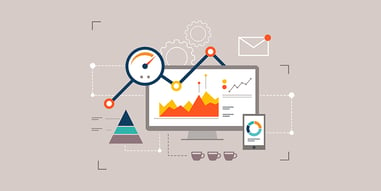Introduction
The CFO of today is tasked with the organization and management of quintillions of bytes of financial data that is as complex as it is vast. Organizing this data is no easy task and will only get harder as the volume and complexity of information increases. The office of finance is also faced with an uncertain business environment where outside disruptions can have detrimental effects on long-term strategy and outlook. Eventually, the office of finance might run into an issue where they spend more time trying to wrestle with data than they do getting value, analysis, and insights out of it.
Luckily, technology can do a great deal to resolve many of the mechanical issues related to data in the corporate world. Two of the most talked-about solutions to the data deluge are Business Intelligence (BI) and Cloud Financial Planning and Analysis (FP&A) solutions which both work to provide structure and meaning to an organization’s financial data. BI tools such as Tableau and Microsoft Power BI and Cloud FP&A tools like Adaptive Insights, Planful, and Limelight both serve essential functions (scale, interpretation, dissemination) but there are key differences that set the two platforms apart. The Limelight blog has previously explored the differences between the two in terms of their budgeting and forecasting capabilities and has also produced a webinar about the main philosophical and practical differences between the two with our CTO, Jade Cole. See our FP&A Power BI: Does Microsoft Power BI Forecasting & Budgeting Work to learn more.
To summarize, BI is best suited for data distribution and dissemination across an entire organization while Cloud FP&A can also disseminate reports, its features are tailored specifically for the office of finance and provide a modern environment to analyze data and FP&A storytelling.
Now let’s talk about how the two stack up in terms of their capabilities.
BI Software
BI applications are very broad in their approach to reporting. BI’s most common use case is for analysis across the entire organization so it is designed around mass consumption and distribution rather than depth and interactivity. BI reports are generally very descriptive and show performance and trends in an effective and legible way without necessarily explaining the underlying trends and drivers behind them. You cannot use BI tools to change data as much as with other applications, you can only look at it. BI tools are also effective at distributing reports and findings widely across the entire organization.
Cloud FP&A Software
Unlike BI which is geared for as broad an audience as possible, Cloud FP&A is designed specifically for the office of finance, helping them analyze data quicker and create a clearer narrative to assist other departments. Firstly, Cloud FP&A gathers your finance data from ERP, HR, and other source systems. Then, using advanced data structures they manage and organize finance data using industry best practices. Using a more interactive and user-oriented approach finance teams can plan, forecast, and budgets directly within the platform and use features like drivers to accurately create models. FP&A allows users to input information into templates that aren’t in other systems and users are freer to explore and edit their data, based on their security privileges. Lastly, they provide document tools and integrations with PowerPoint to make recurring reports and board books easier to manage. Most FP&A platforms are designed around Microsoft Excel for a familiar feel and usability. Collaboration is another feature heavily emphasized by FP&A that is not as prevalent in BI applications.
Conclusion
While most BI and FP&A applications fall into the two categories mentioned above, there is also a great deal of overlap between the two and most BI and FP&A applications will not fall easily into one or the other category. Some FP&A solutions, for instance, also have many of the distribution and dissemination features of BI applications and so can be used for company-wide planning and forecasting. In general, however, FP&A is for the finance team and interactivity while BI is for everyone and sacrifices department specificity in favor of wide distribution and consumption. As Limelight’s CTO likes to say, BI and FP&A solutions can be categorized into a Venn diagram with some overlap between the two but two larger discrete sections with different capabilities.
Peter Drucker, the Austrian-American management consultant, and educator was famous for his maxim “you can’t manage what you don’t measure,” referring to the imperative of data management and control for the modern corporation, an imperative that will only grow in importance as the business environment becomes less certain and secure. BI and FP&A are both tools with complementary features that can help organizations get on top of and control the deluge of data that will only increase in complexity and size.
Leading Cloud FP&A Software with Limelight
In order to get a job done right, you need the right tool for the job. While BI software offers powerful benefits to businesses, when it comes to FP&A, BI software can't compare to a dedicated FP&A platform; it can't compare with Limelight cloud FP&A software.
With Limelight, you'll be able to leverage faster, more accurate forecasting and more effective ad hoc analysis. You'll also be able to make use of cash flow analysis, corporate financial planning tools, the ability to develop strategic plans that encourage long-term growth, and get a generally clearer picture of your organization's overall financial health. FP&A teams love Limelight because it allows them top put together financial statements as much as 75% faster than by using Excel spreadsheets alone.
Everyone from the chief financial officer to other members of senior management to the sales marketing team to the corporate financial analysts that make up your FP&A team will see real value from Limelight cloud FP&A software, such as:
- Automate data collection
- Unlock insights into your data that drive decision making
- Provide long-term financial planning capabilities
- Provide What-if scenario planning
- Build financial forecasts faster that provide more actionable information
Work with FP&A software that empowers your budgeting, forecasting, planning, and analysis processes so they are completed faster - and more accurately - than ever before. Leverage our sophisticated FP&A platform so you can reduce budgeting and reporting times by 50% while uncovering hundreds of thousands in hidden costs, reduce budget reviews, and give your team its time back.






